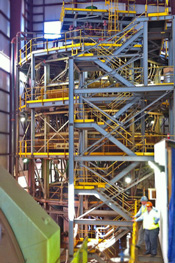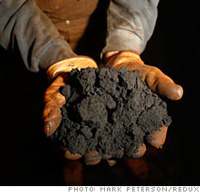Pumping Iron From Junked Rock
Daily News Article — Posted on January 28, 2013
(by John W. Miller, The Wall Street Journal) – For decades, miners in Minnesota left piles of mineral-laced rock, deemed unsalvageable, outside one of the world’s richest iron-ore reserves.
Larry Lehtinen, an engineer with a background in steelmaking and mining, saw opportunity in what was considered waste, especially as iron ore surged in value. Thanks to China’s roaring economy, the price of iron ore – a critical ingredient used to make steel – jumped tenfold in the past decade.
What he needed was a way to efficiently extract the remnants of iron ore and process it into iron pellets that could be thrown into the steelmaking stew. Other methods involving centrifugal force had been developed but they left too much iron ore in the rock, he said.
His solution: a new magnet technology developed by his company, Magnetation Inc., located on the west end of the Mesabi Range, a massive iron-ore deposit in northeast Minnesota. Magnetation now has seven machines that are capable in total of processing seven million tons of iron ore a year.
“It’s a way of getting real value out of what considered waste in the last century,” says Mr. Lehtinen, who is CEO.
Magnetation considers itself a recycler, taking abandoned mining waste and making it useful. Such efforts are expected to become more significant across the mining sector as existing reserves become depleted.
“There’s a whole range of waste product that contain value that technology is being developed to recover,” says Patrick Taylor, a professor at the Colorado School of Mines. He said he has two Ph.D. students exploring whether a mining company might be able to smelt copper from used circuit boards.
Recovering metal from discarded piles isn’t a new concept, but it has been mainly used for precious metals such as gold and silver, says John DeYoung of the U.S. Geological Survey.

Minnesota company Magnetation is making a business of turning waste rock discarded by miners into valuable iron ore used to make steel.
Prices of iron ore were once too low to warrant the extra process. But since 2000, the price per ton has risen to about $123 from $12, making it feasible [capable of being done or carried out] to invest in the technology, says Mr. Lehtinen’s 31-year-old son Matthew, who is president.
Another trend spurring development is the dwindling amount of high-quality ore. During the last century, mining companies flocked to northern Minnesota to extract and ship the highest grades of iron ore on huge ships to steelmaking cities dotting the Great Lakes. Steelmakers weren’t interested in rock with lower concentrations of iron ore, which would require greater heating and processing to make steel.
As a result, commercially unusable rock, known in the industry as gangue, accumulated in massive piles, some six stories high and stretching the length of a football field. Magnetation estimates that there are more than 60 million tons of iron-ore concentrate in those piles, or roughly a year’s worth of the nation’s iron-ore production. The company buys the discarded piles from the mining companies and turns them into a slurry [a thick mixture of water and another substance].
Magnetation was founded by an inventor who came up with type of design called a Ferrous Wheel, using magnets, to extract iron-ore concentrate from a slurry of iron ore. The company was purchased by Mr. Lehtinen, who worked at steelmaker Steel Dynamics Inc. and mining company Cliffs Natural Resources Inc.
He and his two sons started operations in February 2009. Despite some early success, engineers weren’t satisfied with the Ferrous Wheel, whose magnets left behind roughly 65% of what was recoverable and consumed a lot of energy.
The Lehtinens invented a proprietary type of magnet that has a stronger force field and consumes less energy. They also developed a separator machine called the Rev3 that stands 75 feet tall and 40 feet wide and is filled with 120 magnets, each roughly the size of a large car tire. Once the iron-ore slurry is pumped up into the Rev-3, the magnets keep the iron ore in place, while gravity takes the rest of the waste to the bottom.
The captured iron ore is then melted and mixed with other ingredients stipulated by steelmakers. The melted product is spun into marble-sized spheres called green balls. The balls are then cooked at 2,200 degrees Fahrenheit that contain 62% to 65% iron content, which is the level of high concentrate iron ore.
Magnetation has begun selling the pellets to two steelmakers, AK Steel Corp., based in Middleton, Ohio, and Mexican steelmaker Altos Hornos de Mexico SAB de CV.
AK Steel has entered into a joint venture with Magnetation to build a plant that could produce three million tons of iron-ore pellets for the steelmaker, which consumes about six million tons a year. “Right now, we don’t own any iron-ore supplies and have been subject to the volatile swings of the iron-ore market, says AK Steel spokesman Barry Racey. AK said in October that it has agreed to invest $297.5 million in the project. …
NOTE: This article was first published at wsj.com on Dec. 10, 2012.
Copyright 2012 Dow Jones & Company, Inc. All Rights Reserved. Reprinted here for educational purposes only. Visit the website at wsj.com.
Background
Here is how Magnetation extracts iron ore from rock:
- Rock slurry is pumped through a machine called the Rev3 Separator, which is 75 feet tall and 40 feet wide, and equipped with 120 magnets.
- Magnets hold the iron ore particles stationary while waste is flushed away.
- The captured iron ore is transformed into pellets and shipped to steel mills.
- Seven machines in place are capable of processing a total of seven million tons of iron ore a year. (from the WSJ article)

